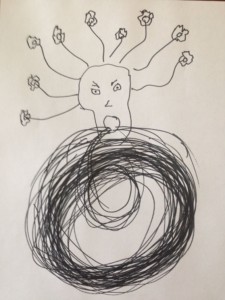There are three touchstones that are the foundation and starting point when creating a writing practice. I choose to use the word “touchstone” rather than “steps to follow” because this isn’t a linear process you go through once and never have to do again. The creative writing process is simultaneous and continuous.
Touchstones are what you come back to time and time again to put your weary hands, heart, and head on when you get stuck, blocked, or simply don’t know how to start writing. These touchstones keep your writing true, real, authentic. They help you determine and maintain the quality and genuineness of your work.
Touchstone 1: Let Go of Your Agenda
The reason writing is hard, especially in the beginning, is because you have an agenda. The root of the word agenda literally means “list of things to be done.”
This list includes any ideas or feelings you have about how the writing should be. It also includes all the reasons why you think it isn’t good enough when it actually hits the page. Before you’ve even begun, there is pressure and expectation for it to be something, which usually boils down to being good.
Every writer wants to be good, to write well, and to say something important, witty, meaningful, profound. Every writer wants to be liked, admired, validated and acknowledged. But there is nothing that will freeze you more before a blank page than needing others to approve of and like what comes out of you, even you.
We create agendas because we believe they will keep us safe and in control. The blank page is scary. You don’t really know what will show up. But creativity is messy. Creativity cannot be controlled. You have to let go and allow alchemy and magic.
Touchstone 2: Follow & Nurture Your Creative Spirit
Q: What is creativity?
A: The relationship between a human being and the mysteries of inspiration. —Elizabeth Gilbert, Big Magic: Creative Living Beyond Fear
Your creative spirit is the foundation of your writing process and life. It’s the ground upon which a nourishing and sustainable writing practice is built and maintained, and it is always the place to begin.
Creativity is not something you have or don’t have. It’s the very state of who you are.
There is a power inside you that wants to emerge and create something new. When you write, you align with this inner power–a mysterious intelligence that gives meaning to the experiences, worlds, characters, wisdom, joys and pain rooted deep in the fabric of your particular life. Your invisible inner source, your soul, merges with the world of form–language–and something new is born. This is what it means to be a Creator.
When you follow your creative expression without it needing to do or be anything other than what it is, you experience your own divinity. Experiencing your own divinity, your own creative spirit IS what calls you to write.
Touchstone 3: Befriend Your Fear & the Great Unknown
“Real fearlessness is the product of tenderness. It comes from letting the world tickle your heart, your raw and beautiful heart. You are willing to open up, without resistance or shyness, and face the world. You are willing to share your heart with others.”
― Chögyam Trungpa, Smile at Fear: Awakening the True Heart of Bravery
The call that awakens the soul to greater expression also stirs our deepest fears. Fear shows up and gets directly in your face when you move toward creating something real. There’s no avoiding it.
Fear is a constant companion in the process of creation and exposure, the process of becoming more visible, and thus more vulnerable, to yourself and others. The voice of fear notoriously throws creative self-doubt in the face of EVERY writer, myself included.
What will people think? What will my family say? What if I’m not good enough? Does this really matter? Hasn’t this been done before? Who do you think you are? Who really cares? You’re not a real writer, you haven’t been published, you need to learn more…there’s a right way to do this that you’ll never figure out…etc. etc. etc.
Rather than waste creative energy and resources answering this voice, arguing with it, banning it, fighting it, or wishing it away, you must befriend it. You must invite it in for tea, and even count on it, like a trusted friend, to guide you where you need to go.
Buddhist temples (and many sacred spaces) throughout the world are guarded by a menagerie of frightening gargoyles, demons, and creatures. They mark the pathway that leads to the golden Buddha at the heart of the temple where the deepest teachings are kept and revealed. The only way to get to the golden heart of the temple is to walk through the creatures and the fear they invoke. Their very presence indicates that you are on a sincere path.
The key is to see your fear, to become intimate with its faces, and to recognize and honor its role in protecting and guarding your deepest self. The key is to not let it stop you from crossing the threshold and entering the temple your life’s expression and its golden teachings, especially when you can’t see where you’re going or what’s there.
Fear tries to protect you from the unknown. Fear tries to protect you from the pain you’ve already experienced. And in doing so, fear reveals the sincere path.
Every writer must begin and return to the three touchstones of the creative writing process (writing without an agenda, following and nurturing your creative spirit, and befriending your fear and the great unknown) if you truly want to find flow and write what wants to be written into the history/herstory/their story of the world through you.


